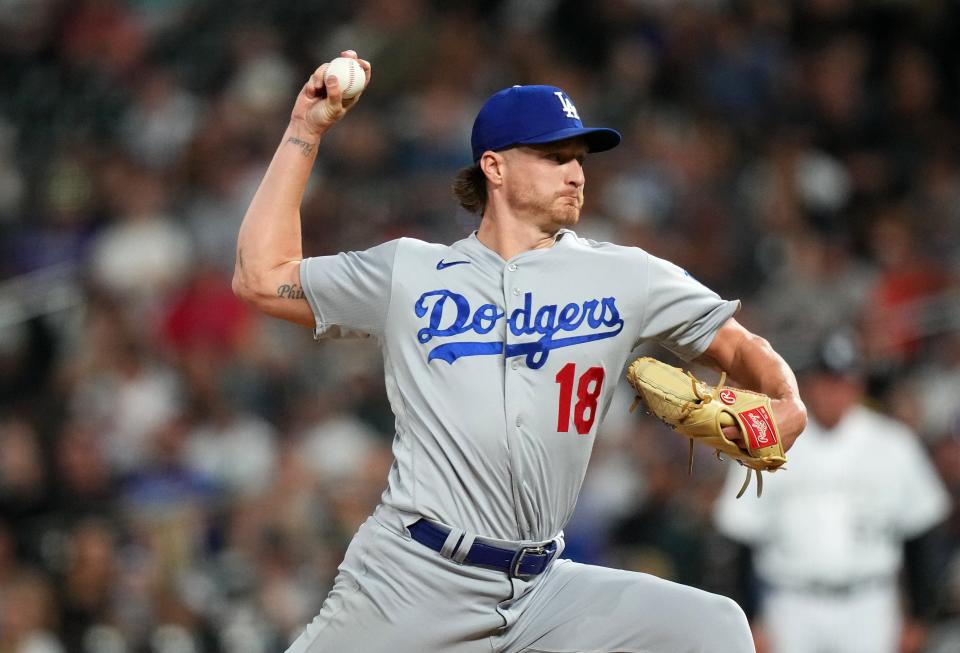Detroit Tigers' Shelby Miller had elite fastball, but Dodgers helped him complement it
Last offseason, Shelby Miller signed with the Los Angeles Dodgers and arrived at their spring training complex looking to become a serviceable reliever in the big leagues for the first time in his career. It was more than a half-dozen years after he made the All-Star team as a starting pitcher and although he moved to the bullpen before the coronavirus pandemic, he hadn't been effective.
He was met at the Arizona facility by Dodgers assistant pitching coach Connor McGuiness to answer get-to-know-you questions from his new organization before working on his pitches ahead of spring training.
That meeting occurred about 12 months ago.
"He's kind of their pitch development guy," Miller said of McGuiness, whom he first met in January 2023. "Really knows how the body works, very smart guy, knows a lot about pitching. He sat me down and told me that he thought I should throw a splitter. I was shocked."
ROSTER PREDICTION 2.0: Five new players acquired by Tigers before New Year's Day

Miller, an 11-year MLB veteran with eight years of service time, spent spring training developing a splitter with the Dodgers. He then went on to post a 1.71 ERA over 42 innings last season and signed a one-year, $3 million contract with the Detroit Tigers this offseason. The 33-year-old agreed to a club option for the 2025 season and can unlock supplemental compensation with performance bonuses.
Scott Harris, the Tigers' president of baseball operation, believes Miller has the potential to work his way into the closer role in the 2024 season, though he also has the versatility to pitch multiple innings.
"We are trying to create an environment that allows pitchers to make those changes and meaningfully improve their futures," Harris said. "Shelby did a great job with the Dodgers, and the Dodgers deserve a lot of credit, but so does Shelby because he was open-minded and willing to make changes."
About 12 months ago, McGuiness — who has worked for the Dodgers for more than seven years — wanted to know about Miller's recent history. The previous year, the New York Yankees taught Miller a slider (with sweeping action) before the San Francisco Giants got their hands on him to finish the 2022 season.
Miller initially thought the Dodgers signed him for the 2023 season because of his new slider. He couldn't have been more wrong. The Dodgers actually signed Miller because of his sneaky-elite fastball.
His four-seam fastball is elite because of the angle at which the pitch enters the strike zone as it crosses the front of home plate, known as its vertical approach angle.
"He has the elite extension with the low-release ride," McGuiness said. "I tried to explain to him, 'Look, your best pitch is your fastball. I know the sweeper is cool on paper and sexy with the data numbers, but in reality, it's going to be much easier to throw a first-pitch strike with your fastball and execute a two-strike pitch with your fastball.' He wasn't all that into it at first. When I sat him down, I went through some of the numbers for him."
10 PREDICTIONS: Forty homers, rookie rakes, a new closer and more for Tigers in 2024

But Miller needed to develop a secondary pitch to complement his fastball and take down left-handed hitters as well as right-handed hitters. Left-handed hitters crushed Miller throughout his career.
The splitter, curveball, and cutter are platoon-neutral pitches, and unbeknownst to McGuiness, Miller tinkered with a splitter earlier in his career but hadn't thrown it for many years.
So McGuiness and Miller revamped his old splitter.
"We made some tweaks to try to get the seam orientation correct to catch a little more depth for him," McGuiness said. "We wanted him to throw the crap out of it with conviction. We didn't want him to have to feel or finesse the pitch."
"I picked it up and started playing catch with it," Miller said. "We got a grip we liked. The rest is history. It's something I feel confident throwing in any count now."
In the 2023 season, MLB pitchers threw the splitter just 2.2% of the time but held opponents to a .199 batting average and .317 slugging percentage. The splitter has been the best-performing pitch in baseball over the past five years: .196 batting average and .310 slugging percentage.
Turns out, the splitter was the perfect complement to Miller's fastball.
His four-seam fastball averaged 17.5 inches of induced vertical break, while his splitter averaged 5.9 inches of induced vertical break. The difference means Miller averaged 11.6 inches of separation between the fastball and the splitter with the Dodgers in 2023.
McGuiness explains it best.
"Imagine being a hitter and you have to face Shelby. Let's say his fastball and sweeper. The approach you're going to have as a hitter, to cover those two pitches, is very different from an approach where you have to cover fastball and splitter with a sweeper. There were a couple of articles during the postseason on what the (Texas) Rangers did against (Houston Astros pitcher Cristian) Javier of just, 'Hey, this is a super-hoppy fastball. We really got to get above this pitch, almost try to hit a ground ball on his fastball.' They were able to barrel him up and take advantage of some mistakes he made.
"With Shelby, it's a very comparable fastball and very special. It's going to be super hoppy with a weird, unique look, so you almost feel like you have to get above it. When a hitter is prone to that, now you also have to deal with a very firm splitter that has the reverse depth. Let's say he's at a 20-vert on his fastball, you really got to get above that to do damage with it, and then he drops a 6-vert splitter, that's over a foot in separation of movement. Your swing decision, you better know what's coming or you're going to be off on that."
[ MUST LISTEN: Make "Days of Roar" your go-to Detroit Tigers podcast, available anywhere you listen to podcasts (Apple, Spotify) ]
The fastball, more so than the splitter, is the foundation for Miller's potential as a high-leverage reliever with the Tigers in 2024.
The combination of average velocity (93.5 mph), above-average induced vertical break (17.5 inches), low release point (5.31 feet) and high extension (7.3 feet) creates a unique angle in which Miller's fastball crosses home plate, making his fastball difficult for batters to hit for damage. (For four-seam fastballs, the MLB average was 16 inches for induced vertical break, 5.88 feet for release point and 6.4 feet for extension over the past three seasons.)
Miller's fastball, for all those reasons, has perceived rise and appears a lot faster than 93.5 mph to batters.
"He already has the unicorn fastball," McGuiness said. "He gets to 19 inches of vert, but at his 5-foot-3 release height, his 19 is going to play like 21 inches, and if we can maintain his velocity above 93, he has something really special. You don't have to do a lot of work on that front, so the question becomes, how do we complement this special pitch?"
That's why the Dodgers helped Miller add an 85.6 mph splitter into his pitch mix.
NEW YEAR'S RESOLUTIONS: Why Tigers should target Alex Bregman in next year's free agency
Shelby Miller developed a splitter and used it 26% of the time last year.
.136 BA
.197 woba
82.1 avg exit velo
30.7% whiff
Really solid signing, especially at $3 mil. Love the front office is building in club options too.
🎥baseballsavant pic.twitter.com/imYwVoaKLf— Clay Snowden (@clay_snowden2) December 22, 2023
Miller threw three pitches last season: four-seam fastball (57.6%), splitter (26.2%) and slider (16.1%). Opponents hit .110 with a .178 slugging percentage against his fastball and .136 with a .250 slug against his splitter. His fastball and splitter had 25.8% and 30.7% whiff rates, respectively.
His 11.7% walk rate last season is one reason to be concerned, but after returning from a neck injury in late August, he tossed 12 scoreless innings with one walk (an intentional walk) and 11 strikeouts to finish the regular season. He then delivered two scoreless innings with zero walks and three strikeouts in the National League Division Series in the postseason.
"He even had a save for us," McGuiness said. "It was a huge save. We were a little banged up in Pittsburgh. I'll never forget that. I couldn't be prouder of the guy. Don't get it twisted, this was all him. We gave him little nuggets and little breadcrumbs. When I heard he was going to Detroit, I was bummed out because I would have loved to see him back in our bullpen, but he's in really good hands."
The Tigers are counting on Miller to repeat his post-injury performance in 2024. If he does, the Tigers will be inclined to pick up his $4.25 million club option for 2025.
Miller, now a Tiger, praised the Dodgers — naming McGuiness, pitching coach Mark Prior, bullpen coach Josh Bard, and manager Dave Roberts — for their efforts in potentially turning around his career. He is confident, for the first time in a long time, that he will pitch for many more years in the big leagues.
"It's a credit to everybody," Miller said. "Connor taught me the pitch and recommended it. After that, he let me go with it. Those guys definitely played a big part in my success. It's a good group over there with a good thing going. They definitely deserve a little bit of credit, right? It can't just be all myself."
Contact Evan Petzold at epetzold@freepress.com or follow him @EvanPetzold.
Listen to our weekly Tigers show "Days of Roar" every Monday afternoon on demand at freep.com, Apple Podcasts, Spotify or wherever you listen to podcasts. And catch all of our podcasts and daily voice briefing at freep.com/podcasts.
This article originally appeared on Detroit Free Press: Dodgers helped new Tigers reliever Shelby Miller find confidence again

